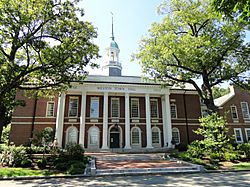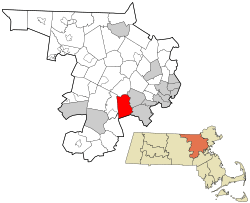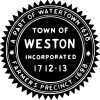Weston, Massachusetts facts for kids
Quick facts for kids
Weston, Massachusetts
|
||
|---|---|---|

Town Hall
|
||
|
||

Location in Middlesex County in Massachusetts
|
||
| Country | United States | |
| State | Massachusetts | |
| County | Middlesex | |
| Settled | 1642 | |
| Incorporated | 1713 | |
| Area | ||
| • Total | 17.3 sq mi (44.9 km2) | |
| • Land | 17.0 sq mi (44.1 km2) | |
| • Water | 0.3 sq mi (0.8 km2) | |
| Elevation | 180 ft (55 m) | |
| Population
(2020)
|
||
| • Total | 11,851 | |
| • Density | 685.0/sq mi (263.94/km2) | |
| Time zone | UTC-5 (Eastern) | |
| • Summer (DST) | UTC-4 (Eastern) | |
| ZIP code |
02493
|
|
| Area code(s) | 781 / 339 | |
| FIPS code | 25-77255 | |
| GNIS feature ID | 0618245 | |
Weston is a town in Middlesex County, Massachusetts United States, about 15 miles west of downtown Boston. At the time of the 2020 United States Census, the population of Weston was 11,851.
Weston was incorporated in 1713, and protection of the town's historic resources is driven by the Weston Historical Commission and Weston Historical Society. The town has one Local Historic District, 10 National Register Districts, 26 Historic Areas, and seven houses individually listed on the National Register of Historic Places.
Weston's predominance as a residential community is reflected in its population density, which is among the lowest of Boston's suburbs near or within Route 128. More than 2,000 acres, or 18 percent of the town's total acreage, have been preserved as parks, fields, wetlands, and forests, with 90 miles of trails for hiking, horseback riding, and cross-country skiing. Thirty-seven scenic roads, as defined by Massachusetts law, maintain the town's aesthetic value and historical significance, affording Weston a semi-rural ambiance. The town is an upper class suburb of Boston, and is among the most affluent in New England.
Contents
History
The town of Weston was originally established as the West Precinct of Watertown in 1698. The town was separately incorporated as the town of Weston in 1713.
Weston is located on a rugged upland plateau. Early settlers discovered that the amount of useful agricultural land was limited as was the waterpower potential in the town. But colonists moving in from Watertown in the mid-17th century established scattered farms in Weston, and by 1679, a sawmill, several taverns, some doctors, and according to the historians, "probably some lawyers," had settled in Weston.
By the 18th century, residents were profiting by the traffic on the Boston Post Road. Taverns of great historic importance were established on the Road. The Golden Ball Tavern, built in 1750, and the Josiah Smith Tavern, built in 1757, still exist in the town. Unfortunately, commercial stagnation followed the loss of business after the opening of the Worcester Turnpike in 1810 drew commercial traffic from the Boston Post Road. Townspeople turned to boot and shoe making, and the manufacturing of cotton and woolen mill machinery. By 1870, substantial country estates were being built in Weston by Bostonians, establishing a prosperous residential character for the town. Farming continued to be a significant support for the local economy, and an organ factory opened in 1886 which employed some residents. The Weston Aqueduct and Reservoir were built in 1903 and the Hultman Aqueduct followed in 1938 to bring Quabbin Reservoir water into Boston. In exchange, Boston residents continued to build homes in Weston, many of them architect designed.
Some famous architects such as McKim and Richardson designed luxurious houses in the town, which witnessed a rapid increase in population from 1920 to 1935, and then again after World War II. The Boston oriented suburbanization has continued as a major factor in the town's development. Residents are very proud of the town's school system and the handsome homes in quiet, well-kept neighborhoods, but tend to brush off the town's reputation as one of the most affluent communities in the state. Weston has carefully retained significant amounts of open space and maintains over 60 miles of hiking and horseback riding trails, playgrounds, ball fields, golf courses and cross-country skiing areas.
Weston was also the home of the E. and G.G. Hook & Hastings organ company until a fire destroyed the factory in the early 1900s. After the fire broke out the fire department responded however the water source (Stony Brook) was just on the other side of the railroad tracks. As the firemen were fighting the fire a train came along and cut all the hoses leaving the firemen without water and having to scurry to replace the cut hoses. Unfortunately for the factory this required more time and the fire consumed the wooden factory.
Weston is also home to many important events regarding the revolutionary war, with the most important being a through way for the Noble Train of Artillery led by Henry Knox. Along with several other towns along the route that Knox took, Weston serves as an important reminder of this selfless and punishing act that helped the revolutionaries win the war.
Geography
According to the United States Census Bureau, the town has a total area of 17.3 square miles (45 km2), of which 17.0 square miles (44 km2) is land and 0.3 square miles (0.78 km2), or 1.85%, is water. The town has a serious problem with deer overpopulation, and is using controlled bow hunting to address the problem.
Demographics
| Historical population | ||
|---|---|---|
| Year | Pop. | ±% |
| 1850 | 1,205 | — |
| 1860 | 1,243 | +3.2% |
| 1870 | 1,261 | +1.4% |
| 1880 | 1,448 | +14.8% |
| 1890 | 1,664 | +14.9% |
| 1900 | 1,834 | +10.2% |
| 1910 | 2,106 | +14.8% |
| 1920 | 2,282 | +8.4% |
| 1930 | 3,332 | +46.0% |
| 1940 | 3,590 | +7.7% |
| 1950 | 5,026 | +40.0% |
| 1960 | 8,261 | +64.4% |
| 1970 | 10,870 | +31.6% |
| 1980 | 11,169 | +2.8% |
| 1990 | 10,200 | −8.7% |
| 2000 | 11,469 | +12.4% |
| 2010 | 11,261 | −1.8% |
| 2020 | 11,851 | +5.2% |
| * = population estimate. Source: United States Census records and Population Estimates Program data. |
||
As of the census of 2000, there were 11,469 people, 3,718 households, and 2,992 families residing in the town. The population density was 674.0 people per square mile (260.2/km2). There were 3,825 housing units at an average density of 224.8 per square mile (86.8/km2). The racial makeup of the town was 90.26% White, 1.18% African American, 0.05% Native American, 6.82% Asian, 0.05% Pacific Islander, 0.43% from other races, and 1.21% from two or more races. Hispanic or Latino of any race were 1.90% of the population.
There were 3,718 households, out of which 42.3% had children under the age of 18 living with them, 73.1% were married couples living together, 5.6% had a female householder with no husband present, and 19.5% were non-families. 17.2% of all households were made up of individuals, and 10.5% had someone living alone who was 65 years of age or older. The average household size was 2.85 and the average family size was 3.21.
In the town, the population was spread out, with 28.0% under the age of 18, 7.3% from 18 to 24, 20.4% from 25 to 44, 27.8% from 45 to 64, and 16.5% who were 65 years of age or older. The median age was 42 years. For every 100 females, there were 86.6 males. For every 100 females age 18 and over, there were 79.6 males.
The median income for a household in the town was $153,918 and the median income for a family was $200,000+, figures that had risen to $189,041 and over $230,000 by 2007. Males had a median income of $100,000 versus $58,534 for females. The per capita income for the town was $105,640. About 2.1% of families and 2.9% of the population were below the poverty line, including 1.8% of those under age 18 and 3.9% of those age 65 or over.
Transportation
The Massachusetts Turnpike traverses Weston in an east–west direction in the southern portion of town. The shared highway routes of Interstate 95 and Route 128 pass in a north–south direction on the town's eastern edge. The intersection of the Massachusetts Turnpike and Route 128 is located in southeastern Weston.
Several state highways—U.S. Route 20 (Boston Post Road), Route 30 (South Avenue), and Route 117 (North Avenue)—travel east and west through the town.
As for public transportation, Weston is directly served by three MBTA Commuter Rail stations—Silver Hill, Hastings and Kendal Green—all on the Fitchburg Commuter Rail Line, with an inbound terminus at Boston's North Station while outbound service heads to Wachusett Station in the city of Fitchburg. Two of those three stations (Silver Hill and Hastings), however, are only served near or during rush hour periods with no weekend service. The commuter trains themselves only operate on half-hour intervals during rush hour; at all other times, trains in both directions operate with roughly 1 to 2-hour headways. Interestingly, the extreme southeastern portion of Weston is within one mile of Riverside Station, a park-and-ride facility which serves the Green Line D branch in the neighboring city of Newton. Given its classification as a rapid transit station instead of a commuter rail stop, Green Line service departs from Riverside more frequently at a rate of one train every 6 to 13 minutes. The station is close enough that Weston residents living in the southeastern part of town can easily reach Riverside Station by car in roughly five minutes or arrive via bicycle in 13 minutes. Also barely east of Weston along U.S. Route 20 lies the starting point of MBTA bus route 70 at the Cedarwood bus stop in neighboring Waltham—just half a mile east from the town line. However, as of December 2019, only 10 inbound trips depart from the Cedarwood bus stop on weekdays—all during rush hour periods—with no weekend service.' Bus Route 70 travels from Cedarwood to Central Square in Cambridge to connect with the MBTA Red Line.
Another local bus route—MBTA bus route 558—technically crosses the border into Weston. Unfortunately, no bus stops for this route are located within the town as its only purpose of entering Weston is to gain access to the Route 128 highway for a short express trip to Riverside Station, where passengers can board this bus for service to Waltham and Downtown Boston.
Points of interest
- The Case Estates
- State Police Troop E-1 Barracks
- Golden Ball Tavern
- Regis College, site of the Spellman Museum of Stamps & Postal History
- Weston Friendly Society of the Performing Arts, Massachusetts' second oldest community theater company
- Norumbega Tower
- Miles of natural trails
- “Weston” by Charles Alexander Nelson in Samuel Adams Drake, compiler, History of Middlesex County, Massachusetts, Volume 2 (L-W), 1880, pp. 488–505.
Education
Public elementary and secondary schools
Weston Public Schools operates five schools:
- Country School and Woodland School
- Field School (grades 4–5)
- Weston Middle School (grades 6–8)
- Weston High School (grade 9–12)
Districtwide enrollment in October 2017 was 2,104 students. Among all Weston residents eligible to pursue elementary and secondary education in 2017, 76 percent were WPS students, 22 percent were students at private schools, and 2 percent were home schooled or attended other institutions. WPS has participated in the METCO program since 1967.
Private elementary and secondary schools
- Cambridge School of Weston
- Gifford School
- Meadowbrook School of Weston
- Rivers School
Undergraduate and graduate institutions
- Pope St. John XXIII National Seminary
- Regis College
According to the 2010 U.S. Census, 79 percent of Weston's population over 25 years possesses a bachelor's degree, the third highest percentage among Massachusetts towns, following Carlisle and Sherborn.
Notable people
- Anant Agarwal, professor of computer engineering at MIT and CEO of edX
- Henry T. Brown, chemical engineer and first African American town official
- Frederic C. Dumaine, Jr., American business executive and Chairman of the Massachusetts Republican Party from 1963–1965
- David Frank, producer, composer, classically trained pianist, and founding member of the 1980s R&B group The System
- Sarah Fuller, author and educator who taught Helen Keller
- Jeremy Jacobs, owner of the Boston Bruins
- Mindy Kaling, comedian, actress
- Stephen D. Lebovitz, CEO of CBL & Associates Properties
- Grover Norquist, founder and president of Americans for Tax Reform
- Stephen Pagliuca, managing director of Bain Capital, co-owner of the Boston Celtics
- Anne Sexton, Pulitzer Prize-winning poet
- Amelia Vega, Winner of the Miss Universe beauty pageant in 2003
- Robert Winsor, prominent American banker and financier of the early 20th century
Sports figures
- Ted Alfond minority owner of the Boston Red Sox
- Steve Belkin, owner of the Atlanta Hawks and formerly the Thrashers
- M. L. Carr, former Boston Celtics player and head coach
- Zdeno Chara, former Boston Bruins player
- Adrián González former Boston Red Sox player
- John Harland, golf
- Matt Hasselbeck, former NFL quarterback
- John Havlicek, former Boston Celtics player
- Al Horford, former Boston Celtics player
- Kyrie Irving, current Brooklyn Nets player, former Boston Celtics player
- Isaiah Kacyvenski, former NFL player
- Cedric Maxwell, former Boston Celtics player and current radio announcer
- Bobby Orr, player for Boston Bruins
- David Ortiz, Boston Red Sox DH/1B
- James Pallotta, owner of the Boston Celtics and AS Roma; Founder of Raptor Capital Management
- Robert Parrish, former Boston Celtics player
- Jerry Remy, former Boston Red Sox player and current TV announcer
- Willard Rice, 1924 Olympic hockey player
- Jeff Vinik, owner of the Tampa Bay Lightning and minority owner of the Boston Red Sox
- Kevin Youkilis, former Boston Red Sox player
See also
 In Spanish: Weston (Massachusetts) para niños
In Spanish: Weston (Massachusetts) para niños


